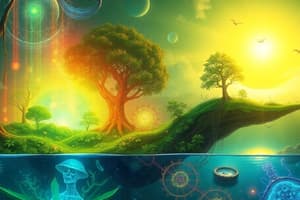Podcast
Questions and Answers
What is the primary purpose of the carbon cycle?
What is the primary purpose of the carbon cycle?
- To facilitate the exchange of carbon atoms (correct)
- To promote bacterial growth
- To circulate water in the environment
- To assist in the formation of fossil fuels
Nitrogen is a nonmetallic element found in Group 15 of the periodic table.
Nitrogen is a nonmetallic element found in Group 15 of the periodic table.
True (A)
What is meant by 'cellular respiration'?
What is meant by 'cellular respiration'?
A chemical process in which oxygen is used to make energy from carbohydrates.
The process that changes liquid water to gaseous water is called __________.
The process that changes liquid water to gaseous water is called __________.
Which of the following is NOT a part of the biosphere?
Which of the following is NOT a part of the biosphere?
Match the processes to their descriptions:
Match the processes to their descriptions:
What is the role of bacteria in ecosystems?
What is the role of bacteria in ecosystems?
The hydrologic cycle refers to the process through which energy is transferred in a closed system.
The hydrologic cycle refers to the process through which energy is transferred in a closed system.
Which of the following biogeochemical cycles is NOT primarily abiotic?
Which of the following biogeochemical cycles is NOT primarily abiotic?
Sulfur is essential for chemical reactions necessary for life.
Sulfur is essential for chemical reactions necessary for life.
What components are included in the hydrosphere?
What components are included in the hydrosphere?
The ________ contains all living organisms on Earth.
The ________ contains all living organisms on Earth.
Match the ecosystem service with its description:
Match the ecosystem service with its description:
Which element is NOT primarily involved in energy transfer indispensable for metabolism?
Which element is NOT primarily involved in energy transfer indispensable for metabolism?
The atmosphere contains all solid land on Earth.
The atmosphere contains all solid land on Earth.
Name a biogeochemical cycle that carbon is a part of.
Name a biogeochemical cycle that carbon is a part of.
Which of the following correctly describes the nitrogen cycle?
Which of the following correctly describes the nitrogen cycle?
The Earth is an open system in terms of carbon and nutrients.
The Earth is an open system in terms of carbon and nutrients.
What is the process of water movement through a plant called?
What is the process of water movement through a plant called?
The _______ cycle describes the transformation of phosphorus in soil, water, and living organisms.
The _______ cycle describes the transformation of phosphorus in soil, water, and living organisms.
Match the following cycles to their descriptions:
Match the following cycles to their descriptions:
Which process results in the breakdown or dissolving of rocks and minerals?
Which process results in the breakdown or dissolving of rocks and minerals?
As energy moves through an ecosystem, it changes form, but no new energy is created. This is known as the conservation of _______.
As energy moves through an ecosystem, it changes form, but no new energy is created. This is known as the conservation of _______.
Precipitation refers to any liquid or frozen water that forms and falls back to the Earth.
Precipitation refers to any liquid or frozen water that forms and falls back to the Earth.
What is a main benefit of high biodiversity in an ecosystem?
What is a main benefit of high biodiversity in an ecosystem?
A healthy ecosystem is one that is vulnerable to change and stressors.
A healthy ecosystem is one that is vulnerable to change and stressors.
What role do trees play in an ecosystem that benefits humans?
What role do trees play in an ecosystem that benefits humans?
Ecosystem services have _____________ value because they provide essential benefits to humans.
Ecosystem services have _____________ value because they provide essential benefits to humans.
Match the following ecosystem services to their descriptions:
Match the following ecosystem services to their descriptions:
In the context of biogeochemical cycles, which component is vital for the movement of matter?
In the context of biogeochemical cycles, which component is vital for the movement of matter?
Ecosystems with low biodiversity are generally more resilient to environmental changes.
Ecosystems with low biodiversity are generally more resilient to environmental changes.
What could happen if abiotic factors in an ecosystem dramatically increased or decreased?
What could happen if abiotic factors in an ecosystem dramatically increased or decreased?
Flashcards are hidden until you start studying
Study Notes
Matter and Energy in Ecosystems
- Conservation of Matter and Energy
- Matter and energy are conserved during ecosystem processes.
- Matter cycles through different forms but is not created or destroyed.
- Energy changes form but is not created or destroyed.
- Earth as a Closed System
- Earth is a closed system for water, nutrients, and minerals.
- Earth does not gain or lose significant amounts of matter from space.
- Energy Flow in Ecosystems
- Energy flows from the sun into plants through photosynthesis.
- Energy is transferred through food chains.
- Energy is lost as heat and does not return to plants.
- Biogeochemical Cycles
- Major biogeochemical cycles include:
- Hydrologic
- Carbon
- Nitrogen
- Oxygen
- Phosphorus
- Sulfur
- These cycles involve the movement of matter between biotic and abiotic components of the ecosystem.
- Major biogeochemical cycles include:
- Essential Elements for Life
- Hydrogen, nitrogen, and oxygen are essential for life due to their bonding properties and abundance.
- Phosphorus is important for energy transfer (metabolism).
- Sulfur acts as a catalyst in chemical reactions necessary for life.
- Earth's Spheres
- Hydrosphere: Includes all water on Earth.
- Geosphere: Includes all solid land on Earth.
- Biosphere: Includes all living organisms on Earth.
- Atmosphere: Includes all air on Earth.
Ecosystem Services
- Ecosystem Services: Benefits provided by ecosystems to humans.
- Support Services: Maintain fundamental ecosystem processes, such as habitat for plants and wildlife, and genetic diversity.
- Provision Services: Material or energy outputs from an ecosystem, including food, fuel, and raw materials.
- Regulating Services: Benefits obtained through moderation or control of ecosystem processes, such as climate regulation, air and soil quality, flood control, and pollination.
- Cultural Services: Non-material benefits humans obtain from ecosystems, such as spiritual enrichment, educational, recreational, and aesthetic experiences.
- Economic Value of Ecosystem Services
- Ecosystem services have significant economic value.
- It would be costly for humans to replicate the services provided by ecosystems.
- Healthy Ecosystems
- A healthy ecosystem is intact in its physical, chemical, and biological components, and is resilient to change and stressors.
- Biodiversity and Ecosystem Health
- Greater biodiversity leads to greater ecosystem stability.
- Species with high genetic diversity and multiple populations are more likely to withstand disturbances, disease, and climate change.
- Ecosystem Response to Changes
- Ecosystems with high biodiversity are more resilient to change.
- Interaction of Biotic and Abiotic Components
- Living and non-living components of an ecosystem interact to provide ecosystem services.
- Examples: Trees provide fiber, filter air, and prevent runoff and erosion.
- Changes to Biotic or Abiotic Factors
- Major changes to biotic or abiotic factors can significantly impact ecosystem services.
- For example, deforestation can disrupt the carbon cycle, reduce biodiversity, and increase soil erosion.
Studying That Suits You
Use AI to generate personalized quizzes and flashcards to suit your learning preferences.




